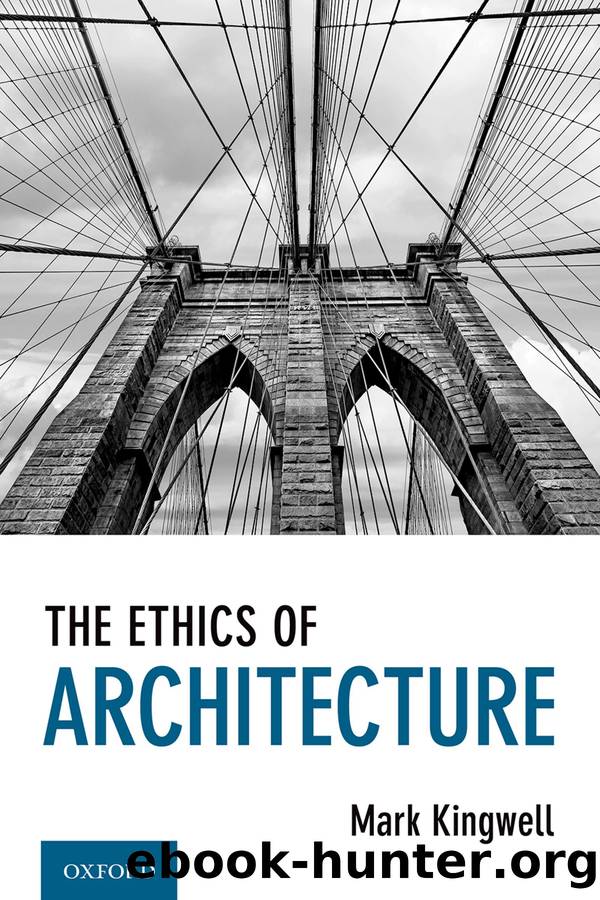The Ethics of Architecture by Mark Kingwell

Author:Mark Kingwell [Kingwell, Mark]
Language: eng
Format: epub
Published: 2021-08-15T00:00:00+00:00
which we must parse in the following twofold sense. First, and most basically, style is bad if it is lazy, inherited without challenge, domineering, moribund, or boring. This is, we might say, standard-issue Modernist reaction to inherited Beaux Arts classicism circa the first part of the twentieth century. The corollary denunciation is implied: if a practitioner relies on an inherited style or, worse, grows complacent in a personal range of effects like a painter or actor rendering the same basic performance, however pleasing, over and over because of audience demand, style has become the enemy of creativity.
Hence style is not banished from the lexicon so much as it is revised to split into mere fashion, on the one hand, and, on the other, what philosophers of mind call an emergent property of an age and its best creative practices. We might imagine a dynamic relationship here, between ground-level practice and high-flown rhetoric that seeks to crystallize the Zeitgeist. The latter is actually necessary for the former to flourish, even it may seem to respond as post-fact theory to ante-facto practice. Without both, and a healthy relation between them, the epoch is diminished overall. Why else, after all, would Le Corbusier have felt it necessary to issue a manifesto for the ânew architecture,â even though it was by all accounts an age in which manifesto was a preferred literary and political form? (Evelyn Waughâs satirical novels Decline and Fall (1928) and Vile Bodies (1930) contain some wry abuse of modernist architectural fashionâone critic judged Waughâs views âreasonably well informed and openly hostileâ7âas well as the choice detail that one character holds a cocktail party for which the invitations are in manifesto form.8)
I pause here to record that Rybczynski, defender of style in architecture, is no fan of fashionable jargon. He has argued that, in the void left from Modernismâs collapse as the governing aesthetic in architecture, theoretical mumbo-jumbo has battled with neoclassicist revisionism for control of the professionâs psych. Neither is a good solution to this void (if it really is one; I frankly doubt it); but the bafflegab of architectural theory is in any event a more obscure enemy to good, performatively ethical building. In a puckish article called âA Discourse on Emerging Tectonic Visualization and the Effects of Materiality on Praxis,â he chides the profession for falling into the sorts of linguistic bogs that have lately afflicted comparative literature and the artworld.9 Discourse itself is defined in this harsh anti-lexicon as âWhat architects talks about when they talk about architecture.â Tectonic is glossed as âNothing to do with geology, it signifies, so far as I understand it, anything to do with building.â Morphosis, Ennead, and Oculus are identified as architecture firms in, respectively, Los Angeles, New York, and Chongqing. (Thatâs pretentious, maybe, but it isnât jargon.)
Personally, I have no quarrel with criticism of alienating, insider-trading expert-speak. I have suffered through more than a few architecture grad-school crit sessions that were suffused with hand-waving and often inaccurate âphilosophicalâ meanderings, usually offered more by the examiners than by the hapless candidates.
Download
This site does not store any files on its server. We only index and link to content provided by other sites. Please contact the content providers to delete copyright contents if any and email us, we'll remove relevant links or contents immediately.
Kathy Andrews Collection by Kathy Andrews(11340)
The remains of the day by Kazuo Ishiguro(8410)
Paper Towns by Green John(4807)
Spare by Prince Harry The Duke of Sussex(4800)
Industrial Automation from Scratch: A hands-on guide to using sensors, actuators, PLCs, HMIs, and SCADA to automate industrial processes by Olushola Akande(4625)
The Body: A Guide for Occupants by Bill Bryson(4590)
Be in a Treehouse by Pete Nelson(3654)
Machine Learning at Scale with H2O by Gregory Keys | David Whiting(3653)
Harry Potter and the Goblet Of Fire by J.K. Rowling(3615)
Never by Ken Follett(3545)
Goodbye Paradise(3458)
The Remains of the Day by Kazuo Ishiguro(3146)
Into Thin Air by Jon Krakauer(3132)
The Cellar by Natasha Preston(3078)
The Genius of Japanese Carpentry by Azby Brown(3041)
Fairy Tale by Stephen King(2961)
120 Days of Sodom by Marquis de Sade(2943)
Drawing Shortcuts: Developing Quick Drawing Skills Using Today's Technology by Leggitt Jim(2943)
The Man Who Died Twice by Richard Osman(2818)
